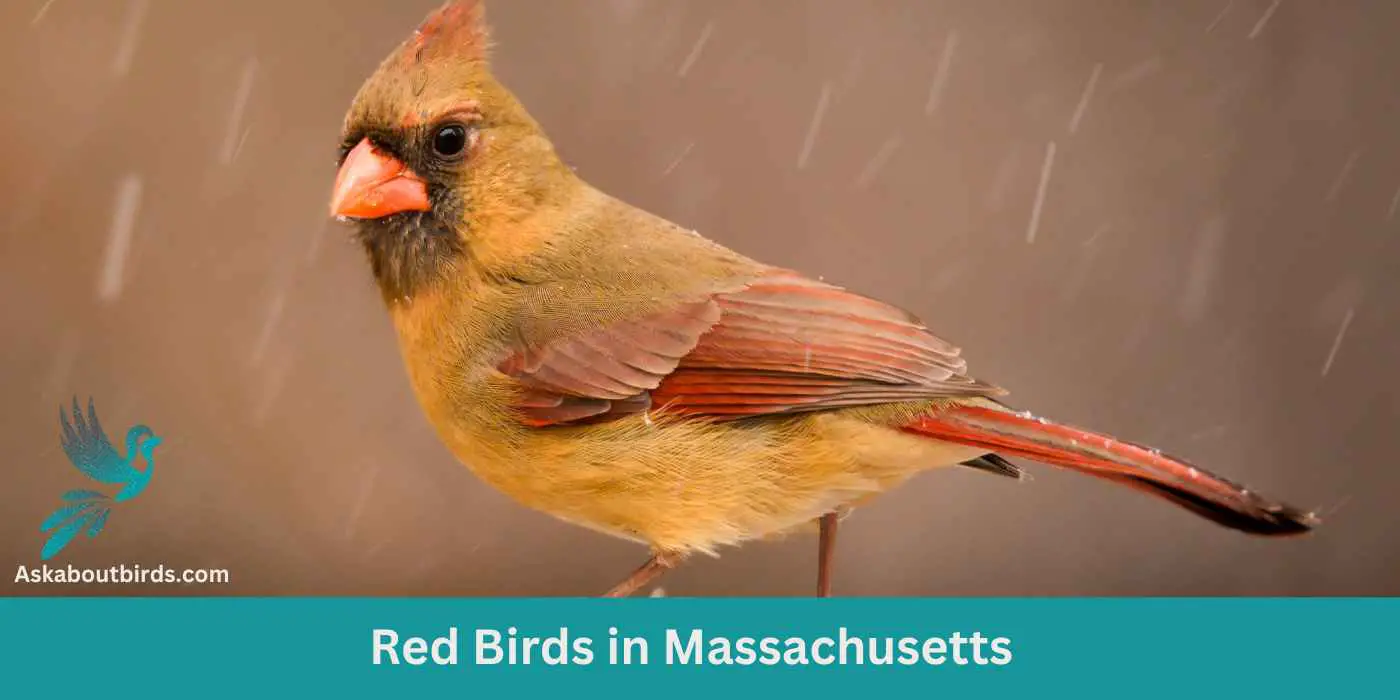Massachusetts boasts a diverse geography, from its Atlantic coastline to rolling hills and dense inland forests, it is a state adorned with avian beauty. While the landscapes vary, one color often stands out against the greenery and skies – the captivating red of some truly magnificent birds.
Join us as we journey through the state’s feathered treasures with a spotlight on the 12 red birds that grace its habitats.
Red Birds Found In Massachusetts
The varied terrains of Massachusetts, encompassing coastal habitats, freshwater wetlands, thick woodlands, and expansive meadows, provide a rich tapestry of environments conducive for avian life.
It’s blend of geographical features and the state’s position on migratory paths that gives birdwatchers and enthusiasts a diverse and ever-changing tableau of avian wonders.
Northern Cardinal


| Feature | Measurement |
|---|---|
| Scientific Name | Cardinalis cardinalis |
| Length | 8.3 – 9.1 in |
| Wingspan | 9.8 – 12.2 in |
| Weight | 1.19 – 2.29 oz |
The Northern Cardinal is an iconic North American bird, easily recognized by its vibrant color and melodious song.
Appearance: Male Northern Cardinals are a brilliant scarlet red, while females display a more subdued reddish olive. Both sexes have a distinctive black ‘mask’ on their face around the bill and a pointed crest on their head. The bird’s beak is robust, cone-shaped, and bright orange in color.
Diet: Northern Cardinals are primarily granivorous, with a diet largely consisting of seeds and grains. They also eat fruits and insects. These birds typically feed off the ground and are frequent visitors to bird feeders.
Reproduction: Northern Cardinals are monogamous, and a pair will breed together for life. The female typically builds a well-hidden nest in a dense thicket or shrub. She lays 2-5 eggs per clutch, which she incubates for around two weeks.
Red-Winged Blackbird
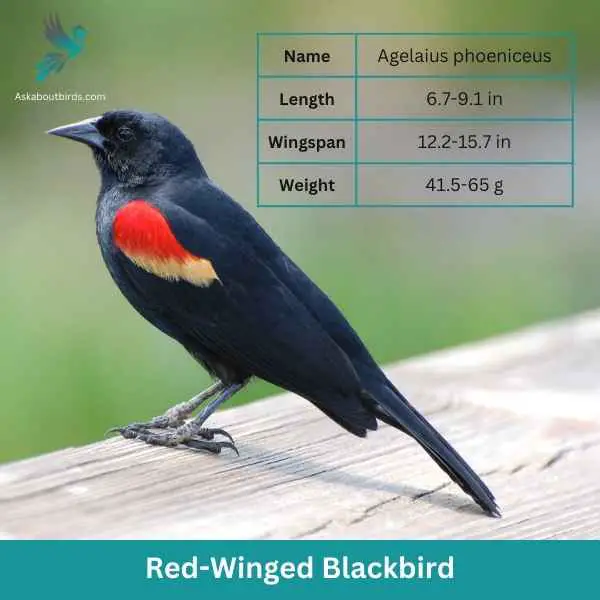
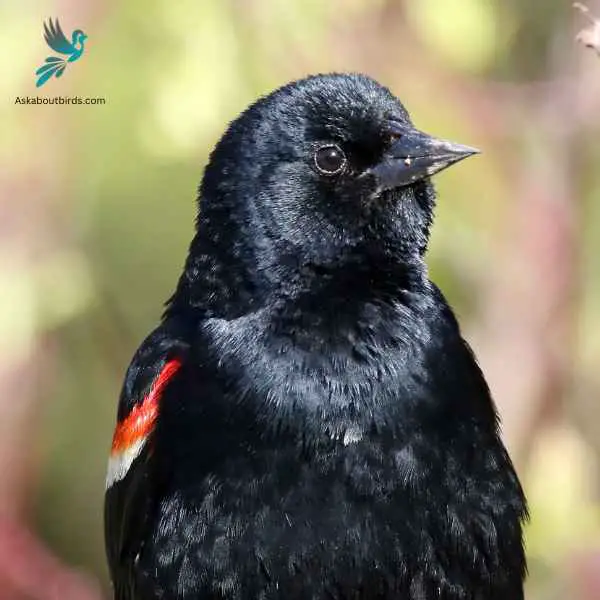
| Feature | Measurement |
|---|---|
| Scientific Name | Agelaius phoeniceus |
| Length | 6.7-9.1 in |
| Wingspan | 12.2-15.7 in |
| Weight | 41.5-65 g |
The Red-Winged Blackbird is a familiar sight across North America, especially in wetlands and open areas. Known for its striking coloration and distinct call, it is often seen perched on cattails or utility lines.
Appearance: Male Red-Winged Blackbirds are glossy black with bright red-and-yellow shoulder patches, while females are streaky brown, resembling a large sparrow. The males’ red patches become more prominent when they’re displaying or agitated.
Diet: Red-Winged Blackbirds primarily feed on seeds and insects. Their diet includes grains, sunflower seeds, and corn, but they also eat beetles, caterpillars, and other small invertebrates, especially in the breeding season.
Reproduction: Red-Winged Blackbirds nest in marshes, along watercourses, and in wet fields. The female constructs a cup-shaped nest using grass and sedge, attaching it to plants above water. She typically lays a clutch of 3 to 4 blue-green eggs, which she incubates for about 11-12 days. Males, being polygynous, often have multiple mates during a single breeding season.
Scarlet Tanager


| Feature | Measurement |
|---|---|
| Scientific Name | Piranga olivacea |
| Length | 6.3 to 7.5 in |
| Wingspan | 9.8 to 11.8 in |
| Weight | 23.5 to 38 g |
The Scarlet Tanager is a strikingly colorful bird known for its brilliant plumage and distinctive song.
Appearance: Male Scarlet Tanagers are notable for their vibrant scarlet bodies contrasted with black wings and tail, making them one of the most intensely colored birds. Females and juveniles, on the other hand, have a subdued olive-yellow body color with darker wings and tail.
Diet: The diet of the Scarlet Tanager is largely made up of insects, including beetles, cicadas, aphids, and others. They are adept flycatchers, seizing insects in mid-air or picking them off foliage. They also consume fruits and berries, especially during migration and in their winter habitats.
Reproduction: The female Scarlet Tanager builds a cup-shaped nest using twigs, rootlets, and grass, typically well-hidden in the dense foliage of trees. She lays 3 to 5 eggs and incubates them for about two weeks.
House Finch


| Feature | Measurement |
|---|---|
| Scientific Name | Haemorhous mexicanus |
| Length | 5–6 in |
| Wingspan | 8–10 in |
| Weight | 0.6–0.9 oz |
The House Finch is a small songbird widely distributed across North America and is commonly found in urban and suburban areas.
Appearance: Males of this species are brightly colored with crimson faces and throats, which can extend to the chest and back, while their flanks have streaks. The female is streaked brown and lacks the red coloring. Both have a square-tipped tail and a distinctively long, flat-topped bill.
Diet: House Finches primarily eat seeds, grains, and berries. They have a particular fondness for sunflower seeds and can be commonly seen at bird feeders. Occasionally, they will also consume insects, especially during the breeding season.
Reproduction: House Finches are cavity-nesters and might choose ledges, vents, ledges, and other urban settings. They might also utilize trees or shrubs. Their nests can be made of a wide array of materials, from feathers to twigs.
Purple Finch


| Feature | Measurement |
|---|---|
| Scientific Name | Haemorhous purpureus |
| Length | 4.7–6.3 in |
| Wingspan | 4.7–6.3 in |
| Weight | 0.6–1.1 oz |
The Purple Finch is a vibrant songbird often mistaken for its close relative, the House Finch, but it exhibits a different hue and patterns.
Appearance: Males are raspberry red on the head, throat, and breast, with streaky brown backs and wings. The intensity of the red can vary among individuals. Females are brown and streaked all over but might show a slight blush on the face. They lack the strong facial patterns seen in female House Finches.
Diet: Purple Finches primarily consume seeds, with a preference for sunflower seeds, dandelion seeds, and buds. They also eat insects and berries, especially during the breeding season.
Reproduction: These finches often nest in conifers or mixed woodlands. The nest, typically located on a horizontal branch, is made from twigs and grass, then lined with feathers.
Red Crossbill
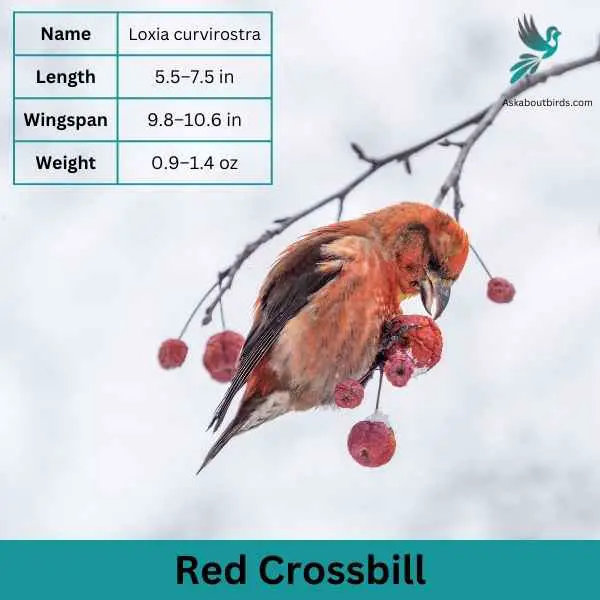
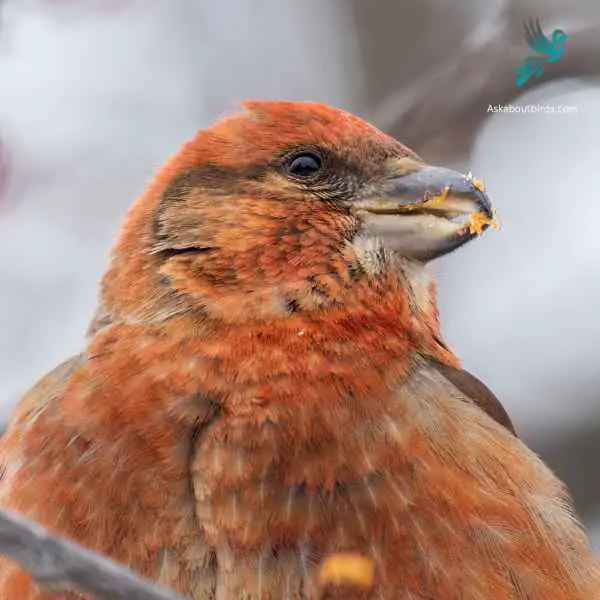
| Feature | Measurement |
|---|---|
| Scientific Name | Loxia curvirostra |
| Length | 5.5–7.5 in |
| Wingspan | 9.8–10.6 in |
| Weight | 0.9–1.4 oz |
The Red Crossbill is a distinctive finch known for its unusual bill, which has evolved to extract seeds from conifer cones.
Appearance: Males are typically bright red or orange, while females are greenish-yellow or olive. Both genders have the characteristic crossed bill, which they use to expertly extract seeds from tightly closed conifer cones.
Diet: Red Crossbills primarily feed on the seeds of coniferous trees, such as spruce, pine, and fir. Their specialized bills allow them to efficiently pry apart conifer cone scales to access the seeds.
Reproduction: Red Crossbills are somewhat nomadic and don’t adhere to a strict breeding schedule. Instead, they breed whenever and wherever food is abundant. Their nests are usually built on horizontal branches of conifer trees.
Pine Grosbeak
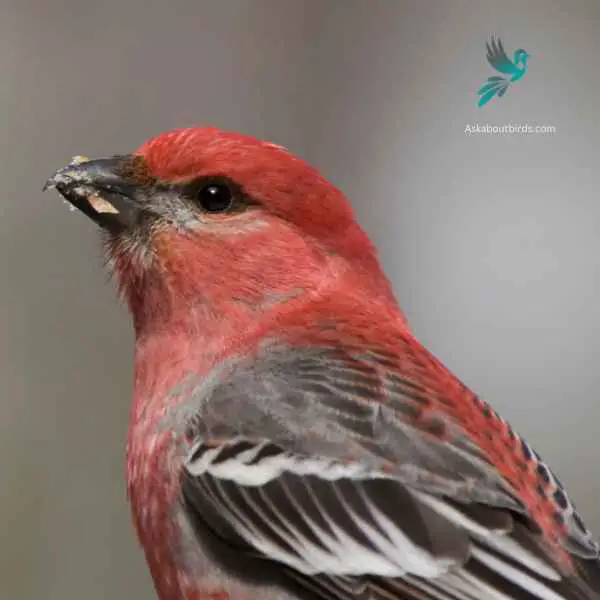
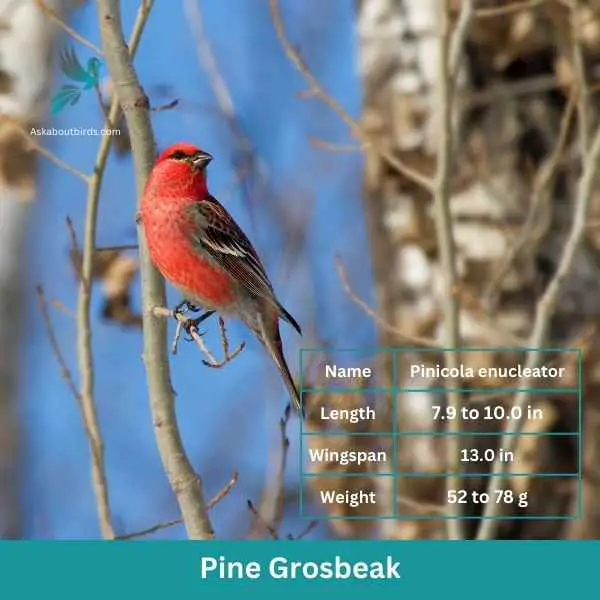
| Feature | Measurement |
|---|---|
| Scientific Name | Pinicola enucleator |
| Length | 7.9 to 10.0 in |
| Wingspan | 13.0 in |
| Weight | 52 to 78 g |
The Pine Grosbeak is a striking bird native to the northern regions of North America, often found in coniferous forests. Both males and females have a plump and robust body with a large beak adapted for eating seeds. The male Pine Grosbeak displays a vibrant reddish-pink plumage, while the female has a more subdued grayish-brown coloration.
These birds are typically seen in small flocks, foraging for food in trees and on the ground. They have a preference for seeds, particularly those from various conifer species. The Pine Grosbeak uses its strong bill to crack open the cones of tall trees and extract the seeds, but they also consume berries and small fruits when available.
American Robins


| Feature | Measurement |
|---|---|
| Scientific Name | Leptotila plumbeicep |
| Length | 10.6-11.8 in |
| Wingspan | — |
| Weight | 160-200 g |
The American Robin is a widely recognized bird species known for its melodious song and early bird tendencies.
Appearance: American Robins are medium-sized birds with a distinctive appearance. Both males and females sport a gray to brown back and a warm red to orange breast and belly and gray wings. They also have a characteristic white eye-ring and a black head, but males are usually darker than females.
Diet: American Robins have a diverse diet that changes depending on the season. In summer, they feed heavily on earthworms, beetles, and other invertebrates, which they catch on the ground. During winter, they mostly eat fruits and berries.
Reproduction: American Robins usually build their nests in trees or shrubs, but they are also known to nest on human-made structures. The female lays a clutch of about 3 to 5 eggs, which she incubates for about 12 to 14 days.
Red-bellied Woodpecker
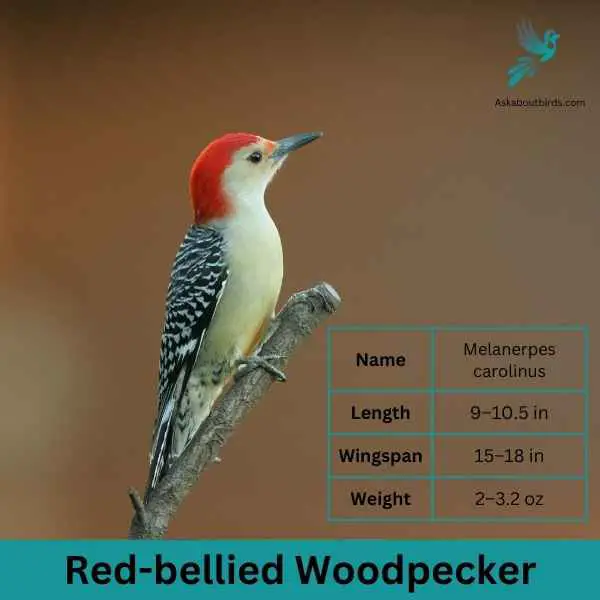
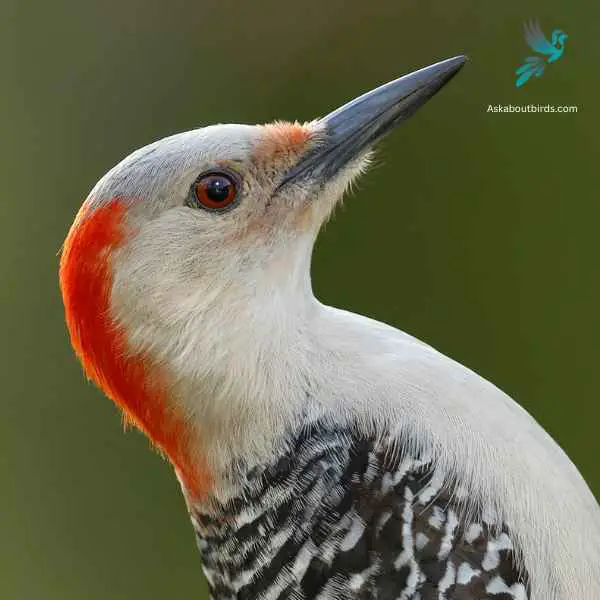
| Feature | Measurement |
|---|---|
| Scientific Name | Thryothorus ludovicianus |
| Length | 4.7–5.5 in |
| Wingspan | 11 in |
| Weight | 0.63–0.81 oz |
The Red-bellied Woodpecker is a medium-sized woodpecker commonly found in woodlands, forests, and backyards across the eastern and central U.S.
Appearance: The Red-bellied Woodpecker sports a pale gray face, throat, and belly, contrasted by a zebra-striped back. Its name derives from the subtle reddish tinge on its belly, but it’s more commonly recognized by the vivid red cap on the head of males and the partial red cap on females.
Diet: This woodpecker has a varied diet that includes insects, fruits, nuts, and seeds. They frequently forage on tree trunks and branches, using their sticky, barbed-tipped tongue to extract ants, beetles, and other insects from crevices.
Reproduction: Red-bellied Woodpeckers are cavity nesters, excavating holes in tree trunks for their nests. The inside of the nest is typically unlined or sparingly lined with wood chips.
Red-headed Woodpecker


| Feature | Measurement |
|---|---|
| Scientific Name | Melanerpes erythrocephalus |
| Length | 7.5–9.1 in |
| Wingspan | 16.5 in |
| Weight | 2.0–3.2 oz |
The Red-headed Woodpecker is a striking forest bird with a bold tri-colored pattern.
Appearance: This woodpecker features a completely red head and neck, contrasting starkly with its white underparts and black wings. Its wings also have large white patches which are conspicuous in flight.
Diet: Red-headed Woodpeckers have a varied diet including insects, seeds, fruits, berries, and occasionally even the eggs of other birds. They’re also known to store food by wedging it into crevices in bark.
Reproduction: These woodpeckers nest in cavities which they excavate in dead wood or dead parts of live trees. These cavities can be found anywhere from 2 to 80 feet off the ground.
Summer Tanager
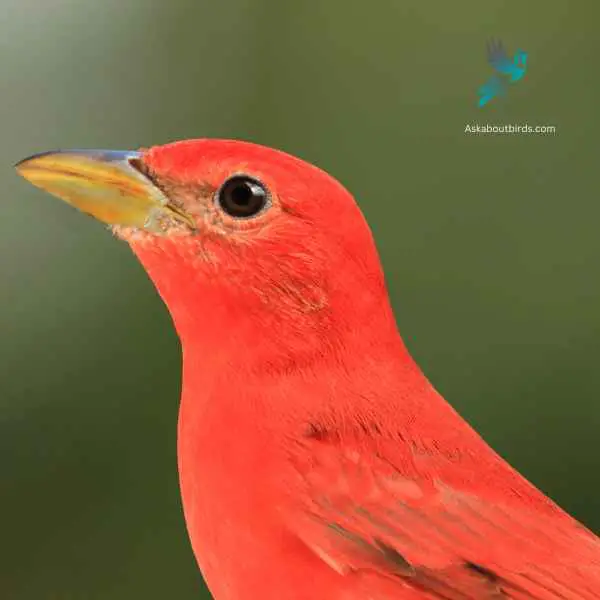
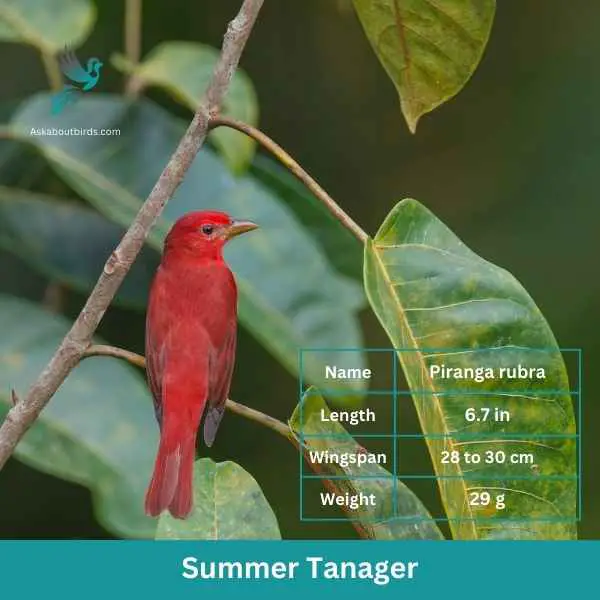
| Feature | Measurement |
|---|---|
| Scientific Name | Piranga rubra |
| Length | 6.7 in |
| Wingspan | 28 to 30 cm |
| Weight | 29 g |
The Summer Tanager is a medium-sized songbird admired for its radiant plumage and melodious song.
Appearance: Male Summer Tanagers are an impressive bright red, while females and juveniles present a softer, yellow-orange color. Both genders have a large, slightly hooked bill and relatively short tail.
Diet: Summer Tanagers primarily feed on insects, including bees and wasps, which they catch in flight or pick off vegetation. They are also known to eat fruits and berries, making them helpful in controlling pest populations and seed dispersal.
Reproduction: The female Summer Tanager builds a loose, shallow cup-shaped nest out of twigs and grass, usually hidden in the foliage of trees. The female typically lays 3-5 eggs, which she will incubate for about two weeks.
Rose-breasted Grosbeak


| Feature | Measurement |
|---|---|
| Scientific Name | Pheucticus ludovicianus |
| Length | 7.5-8.5 in |
| Wingspan | 12.5-13 in |
| Weight | 1.2-1.7 oz |
The Rose-breasted Grosbeak is a songbird of medium size, widely recognized for its vibrant coloration and melodious song.
Appearance: Male Rose-breasted Grosbeaks boast a striking contrast with black and white plumage accompanied by a radiant rose-colored patch on the chest and under the wings. In contrast, females exhibit streaked brown and white plumage, resembling large sparrows but with a thick bill.
Diet: The diet of the Rose-breasted Grosbeak consists of a mixture of seeds, insects, and fruits. During summer, they primarily feed on insects, while seeds and fruits become more prevalent in their diet during the colder months.
Reproduction: These birds build cup-shaped nests typically situated in trees or large shrubs. Both the male and female partake in incubation duties, ensuring the eggs’ safety and warmth. After hatching, the chicks are primarily fed insects.
Where to Spot Massachusetts’ Red Birds
Massachusetts, a haven for birdwatchers, offers a range of prime locations to spot its colorful and diverse avian inhabitants. Here are some top spots that stand out:
- Parker River National Wildlife Refuge, Newburyport: Nestled along the northeastern coast, this refuge is a critical stopover point for migratory birds. Its varied habitats attract a multitude of red bird species, especially during migration seasons.
- Plum Island, Newbury: This barrier island offers a mix of dunes, marshes, and shrub habitats. Its unique ecosystem attracts a variety of bird species, making it a top spot for year-round bird watching.
- Quabbin Reservoir, Belchertown: As one of the largest man-made public water supplies in the U.S., Quabbin’s surrounding woodlands and clearings are home to numerous bird species, including several red varieties.
- Wellfleet Bay Wildlife Sanctuary, Wellfleet: Located on Cape Cod, this sanctuary features a mix of salt marshes, beaches, and pine woodlands, drawing a rich diversity of birds throughout the year.
- Mount Auburn Cemetery, Cambridge: A surprisingly lush urban oasis, this historic cemetery is renowned among birdwatchers, particularly during the spring migration. The beautifully landscaped grounds attract a variety of songbirds, including red species.
| State’s Red Birds | Best Spots for Red Birds |
|---|---|
| Connecticut’s Red Birds | 1. Hammonasset Beach State Park 2. Sherwood Island State Park 3. White Memorial Conservation Center |
| Rhode Island’s Red Birds | 1. Sachuest Point National Wildlife Refuge 2. Trustom Pond National Wildlife Refuge 3. Ninigret National Wildlife Refuge |
| New Hampshire’s Red Birds | 1. Pondicherry Wildlife Refuge 2. Odiorne Point State Park 3. Umbagog National Wildlife Refuge |
| New York’s Red Birds | 1. Central Park, New York City 2. Montezuma National Wildlife Refuge 3. Jamaica Bay Wildlife Refuge |
| Vermont’s Red Birds | 1. Green Mountain National Forest 2. Dead Creek Wildlife Management Area 3. Missisquoi National Wildlife Refuge |
FAQs on Red Bird Species Found in Massachusetts
Which birds feature two white wing bars?
Birds with two white wing bars on their dark gray wings are a distinctive feature in the avian world. This trait can be observed in several species, but is particularly prominent in white-winged crossbills. These stunning birds often visit backyard feeders in eastern North America, particularly when black oil sunflower seeds are on offer.
Are white wing bars present in tropical birds?
White wing bars are not limited to any specific region and can be found in various bird species across the globe. In Central and South America, where the forests teem with bright yellow-green, orange, and red-plumaged birds, some species, amidst the dazzling display of colors, sport the distinctive white wing bars.
How can I attract birds with white wing bars to my backyard?
Birds with white wing bars, like the white-winged crossbills, are often attracted to backyard bird feeders that offer their favorite foods. Providing black oil sunflower seeds in your backyard feeders can entice these beautiful birds to visit, especially if the feeder is near forest edges or canopy.
What makes the painted bunting one of the most colorful birds in Central and South America?
The painted bunting, predominantly found in Central and South America, boasts an array of vibrant colors. Its bright red plumage contrasts starkly with bright yellow-green underparts, making it one of the most stunning birds. While it thrives in forest edges and canopies, it’s not uncommon to find this beautiful bird visiting backyard bird feeders, especially when black oil sunflower seeds are offered. This combination of striking colors and adaptability to various habitats makes it a treasured sight for bird enthusiasts.

